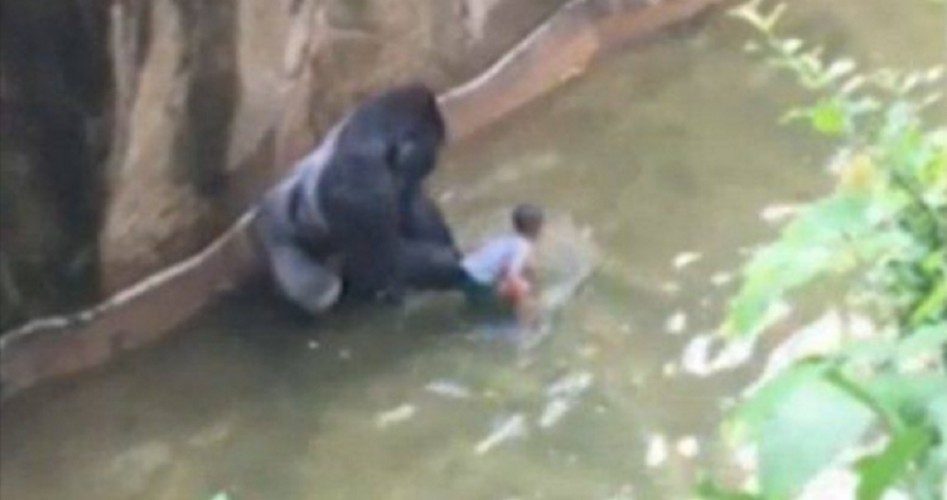
It’s as if we live in The Planet of the Apes, with the overwrought reaction to the recent killing of Harambe the gorilla. The only thing missing is Dr. Zaius complaining about how man is a “warlike creature who gives battle to everything around him.” But no small number of Internet commenters have that misanthropic line covered.
It’s hard not to have heard about the events of this past Saturday, when a four-year-old boy named Isaiah slipped into the gorilla enclosure at the Cincinnati Zoo. Video of the incident captivated the nation, and the outcome — the killing of a 17-year-old silverback (dominant male) gorilla named Harambe in order to save the boy — has evoked rage and calls for retribution.
Many maintain that Harambe didn’t have to be killed, that he was protecting Isaiah and was a victim of trigger-happy zoo officials. In the same vein, an animal-rights group has filed a federal negligence complaint against the zoo. A “Justice for Harambe” Facebook page has been created and already has more than 120,000 likes. Most troubling, though, is what has befallen the boy’s parents, 36-year-old Deonne Dickerson and 32-year-old Michelle Gregg. While a desire to hold them responsible is understandable, they have received indirect death threats, and one man actually messaged that the gorilla “is more important than your [expletive] kid.” Even people who merely share Gregg’s name have been harassed.
Of course, the media hasn’t helped. Many outlets emphasized how Harambe was “holding hands” with Isaiah, and the Drudge Report actually ran a Monday headline reading, “MURDERED GORILLA SEEN ‘PROTECTING’ CHILD.”
We should first note that words have definitions. “Murder” refers to the unjust killing of a human being; thus, it is not possible to “murder” an animal. Moreover, even using the term “unjust” would be odd; animals aren’t subject to “justice,” which can also refer to respecting others’ rights, things animals don’t have (“animal rights” is an oxymoron; we should treat animals well not because they have rights, but because we have responsibilities and, hopefully, love in our hearts). Whatever term we use, however, the killing of Harambe was the right decision.
Much as with the highly publicized police shootings of criminal suspects, people here are rendering emotion-colored opinion based on scant or incorrect information. But just as real-life gunplay isn’t as in the movies, Harambe wasn’t Cheetah the chimp — and there was no Tarzan to talk him down.
Aside from the video, which clearly shows the gorilla violently manhandling Isaiah, eyewitnesses have explained how imperiled he was. For example, CNN reports that after the four-year-old splashed into the gorilla enclosure’s water and a man screamed, “The sound attracted Harambe, who barreled over to the moat, saw the child and then knocked the boy against a wall,” according to Kimberley Ann Perkins O’Connor, who was attempting to take a picture of the animal at the time. CNN continued:
O’Connor, who recorded much of the scene on her phone, said the gorilla didn’t seem intent on harming the boy at first.
“He dragged the child a little further down into the moat and he … almost looked like he was helping him, pulled his pants up, stood him up, and then all of the sudden everybody started screaming again, and he pulled him completely out,” she said.
… The screaming seemed to agitate the 450-pound primate, witnesses said, and the scene quickly deteriorated. The gorilla became more aggressive and was seemingly determined not to free the child, witnesses said.
“From what we saw [the child] could have been killed at any second,” Bruce Davis, who was with Hollifield, told WCPO. “He threw him 10 feet in the air, and I saw him land on his back. It was a mess.”
Then there is the complaint that zoo officials should have used non-lethal means to subdue the animal. As Vox.com tells us:
“It is important to note that with the child still in the exhibit, tranquilizing the 450-pound gorilla was not an option,” the Cincinnati Zoo said in a statement. “Tranquilizers do not take effect for several minutes and the child was in imminent danger. On top of that, the impact from the dart could agitate the animal and cause the situation to get much worse.”
The zoo’s decision to kill Harambe, according to experts, was the right call under the conditions. Jack Hanna, the respected and renowned American zookeeper, told WNBS-10TV that he would have made the same decision.
“It takes 5 to 10 minutes for a gorilla to lay down and go to sleep, so what’s that male going to do if all [of] the sudden, ‘pow’ he feels this thing hit him?” he said. “He’s going to go back there, ‘what is this thing?’ pull it out, and he’s got a child in his hand … We’re going to have a disaster. Within one split second. You wouldn’t even want to witness it.”
As to this, a grown male gorilla is in the neighborhood of 10 to 30 times as strong as a man (we don’t know precisely — it’s hard to get a silverback into a weight room). In other words, Harambe could have torn Isaiah in half or killed him without even intending to do so.
Yet none of these facts may matter much to the mob. As Vox’s Max Fisher wrote last year, “You’ll notice that most of these [Internet mob-justice efforts] trace back not to the crime’s impact on society, but rather the degree to which punishing the crime will feel good for the punishers.” And “feel” is the operative word, as the lack of a sense of proportion here certainly doesn’t reflect rationality.
It’s not surprising that many people anthropomorphize animals. They’re weaned on entertainment (e.g., cartoons) that does so, portraying animals that think and talk as people do; couple this with the environmentalist agenda permeating school curricula and society in general, and it’s a potent one-two punch. In addition, the secularism prevailing in the West holds that man is just another animal, bereft of a soul — merely an organic robot comprising some pounds of chemicals and water.
This mindset can view a rare gorilla as more valuable than a person, who is one of seven billion; hence the comment that Harambe “is more important than your [expletive] kid.” And it isn’t just that one commenter. Did the 2015 Planned Parenthood videos showing abortionists cavalierly talking about selling babies’ body parts for money evoke nearly the same outrage? Note that on the day the gorilla was killed, more than 2,000 babies were murdered via abortion in our nation. And what of the Islamic State’s brutality, burning people alive, drowning them in cages, and committing genocide? Are the calls for justice nearly as intense?
For the record, although I certainly eat meat, I love nature and animals and am the kind of man who avoids killing even bugs whenever possible; I’ve stopped my car to rescue turtles from the road. Life, and respect for it, are beautiful things. But respect for the hierarchy of life, for God’s creation, is both beautiful and necessary. Without it, we really just start to seem like primates with ugly passions.


